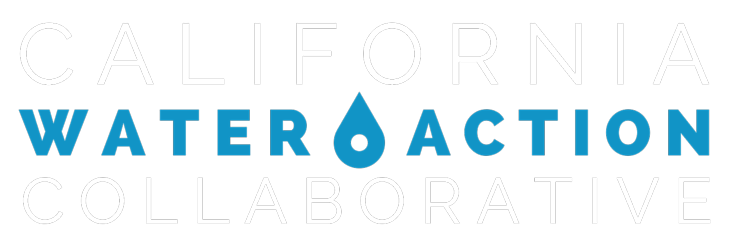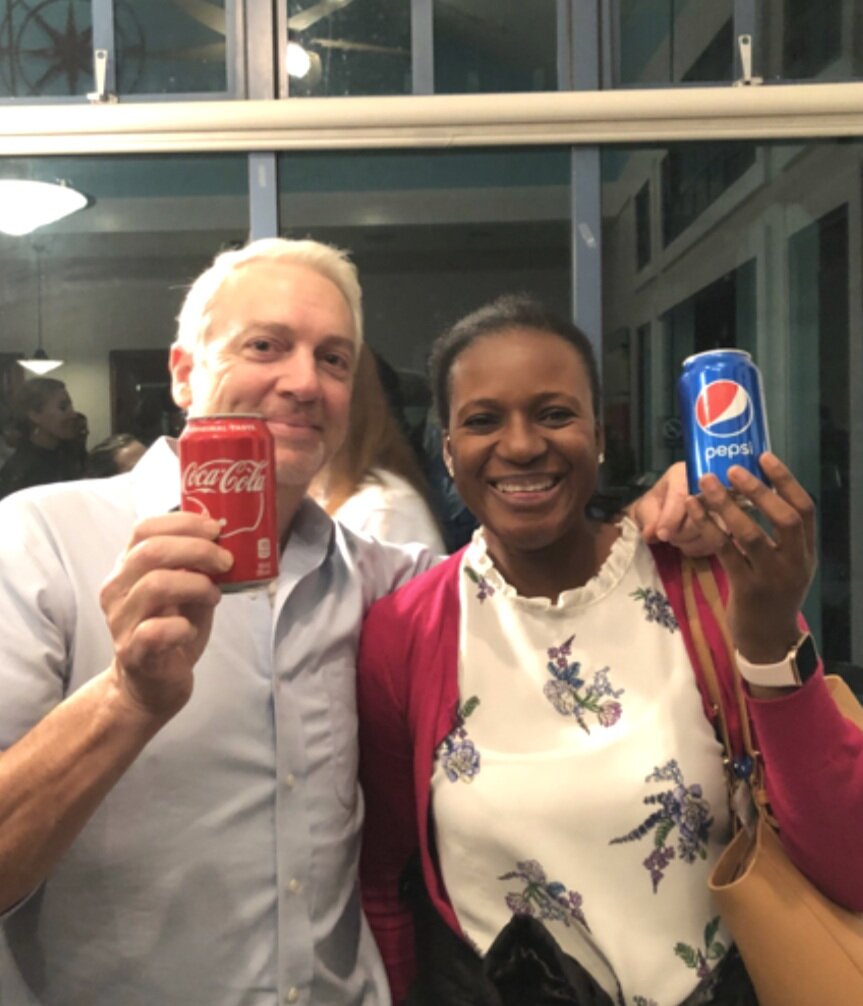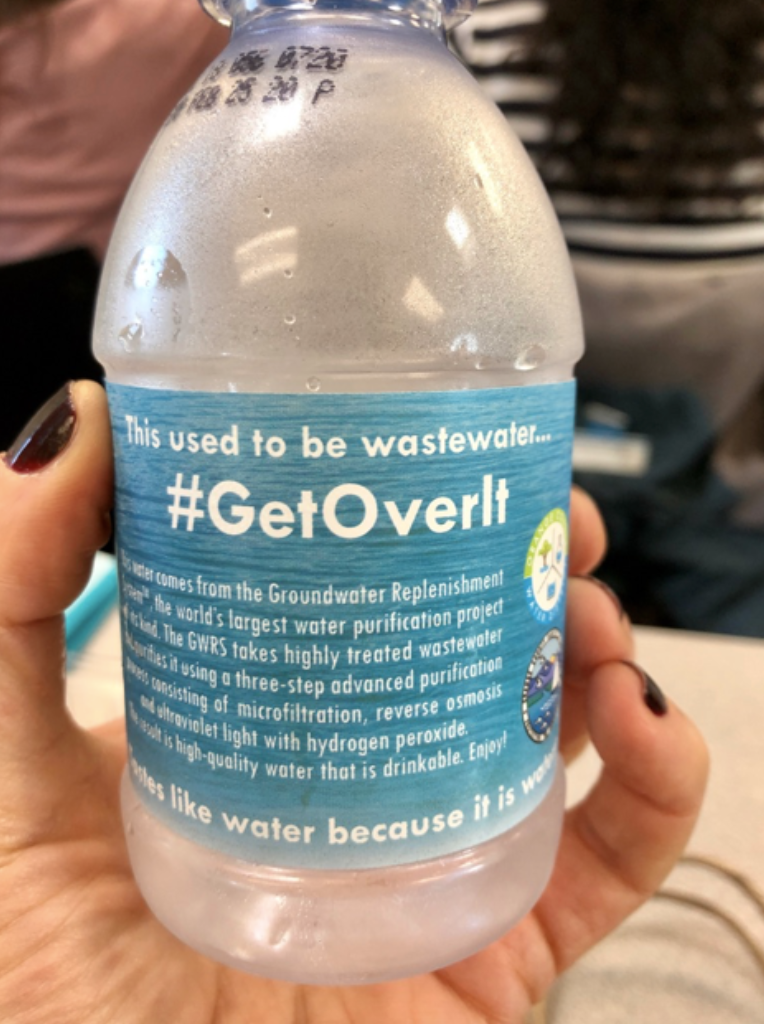Blog by Val Fishman, Bonneville Environmental Foundation, and Robert Gould, Ag Innovations
CWAC members come from around the country and state in the spring and fall to take action through learning and collaboration. Our Fall 2019 CWAC member meeting held in Silicon Valley began on the heels of many CWAC members experiencing fire evacuations, smoke from miles away, and related power outages; an unfortunate ‘new normal’ in California. As always, everyone came ready to engage in productive dialogue and to embrace the need and urgency for collective action.
Pre-competitive Friendship: A CWAC member dinner is where you can find these two beverages served side by side! The two CWAC members featured here are Nyima Dansira from PepsiCo and Jon Radtke from Coca-Cola
Sources to Sinks: Rethinking Urban Water Supply and Demand in the Climate Context
This almost 3-day session connected the dots between urban areas and their headwaters, where we had spent time during the last two meetings. An incredible amount of content and thought-provoking work was packed into another productive, and an “exhaustingly inspiring” 48 hours – accurately described by Google’s Eddie Corwin. Eddie was our generous host at Google’s headquarters in Mountain View along with sponsorship from Microsoft.
A more holistic, Ecosystems-based approach to urban water
With a full day and evening of dedicated work time, we deepened our knowledge of California’s urban water challenges and climate impacts from remarkable guest speakers like Robin Grossinger from the SF Estuary Institute; Newsha Ajami, Director of Urban Water Policy at Stanford’s Water in the West; and Felicia Marcus, former Chairperson of the California State Water Resources Control Board; and our own Jason Morrison, from the Pacific Institute.
The Project Task Force made progress on CWAC project criteria, project priorities, and regionally focused teams excited about moving innovative projects forward and exploring how water projects can be integrated into carbon projects – with a real emerging interest in Blue Carbon. Blue carbon is carbon sequestered in aquatic ecosystems and plants that exceed the uptake rates greater and faster than almost all terrestrial ones: wetlands, sea grass, seaweed and kelp.
Alviso Environmental Education Center at the edge of the wetlands. Dave Cordell, with the US Fish and Wildlife Service, and Dave Helsing, with the South Bay Salt Pond Restoration Project, telling the story of how many agencies, cities, and stakeholders have and are working together to restore many 100’s of acres of wetlands and salt ponds, and protect society.
Wetlands as A Solution
The group packed in a full day of site tours that began with a visit to Ducks Unlimited’s South Bay Wetlands project at the Alviso Environmental Education Center. We learned about the importance of salt marsh wetlands restoration; the features and benefits of salt ponds and marsh - including horizontal levees that grow higher with sea level rise; the connections to creeks and wastewater discharge impacts; as well as the role of such wetlands in the Bay Area with ‘green infrastructure’.
Restored wetlands and salt ponds, and other green infrastructure like horizontal levees, protect communities and water infrastructure against sea-level rise and generate many other benefits. These are great examples of cost-effective green infrastructure protecting grey infrastructure (centralized water and wastewater treatment plants, sewer lines, roads, many commercial buildings, airports, etc. from faster-than-expected sea level rise. A couple of the corporate members expressed interest in exploring collaboration on such projects. This was a new insight as a result of the hands-on learning experience.
Reducing Dependence upon imported water
Next was a visit to the Silicon Valley Advanced Water Purification Center to learn about the three-part process of turning wastewater into some of the cleanest drinking water imaginable!
The first step is micro-filtration to remove large viruses and bacteria.
The second step applies reverse osmosis to remove pharmaceuticals and proteins.
The final step is ultraviolet light (UV) at a high intensity which removes all other pathogens.
We also learned how large-scale water recycling fits into a “OneWater” approach.
Ready for recycled wastewater for drinking?
Cleaner than tap water… We tried it and lived to tell the tale. It was largely uneventful as we realized the issue of drinking recycled water is really psychological.
Valley Water actually pumps the 8 million gallons of recycled water it produces each day back into the ground for consumption at a later time, an approach called Indirect Potable Reuse. This is an innovative large-scale, highly-engineered, and primarily centralized solution that requires a significant amount of energy. It clearly has a role to play, hopefully a much bigger one in Silicon Valley and other urban areas, as it is in Orange County and other places around the world. Yet, questions remain and it is only a piece of the puzzle. Members who use filtration processes were inspired to think about its relationship to clean drinking water in watersheds they work in. Their One Water initiative is an integrated water management approach addresses water conservation for homes and businesses, flood prevention, and ecosystem/creek stewardship.
Tailored to the needs of Silicon Valley’s human needs, as well as those of the local ecosystems and water cycle, their version of the One Water approach enables planners to make better investment decisions by finding overlapping needs and benefits in those three areas, where possible. In addition to an effective conservation program, they, for example, they are restoring parts of Coyote and Penitencia Creeks which reduces flood risks, while increasing habitat and even increasing water recharge.
Distributed Nature-based Solutions
Another dimension of reducing dependence upon imported water is using, reusing, capturing, cleaning water at the facility or campus level. Both Google, and soon Microsoft, are working to not only dramatically reduce water imports and use, but improve water quality landing on (in the form of rain) and leaving its properties. Facilities and landscaping that is quickly moving towards net positive water, providing more clean water to the environment than it uses.
Google provided a tour of distributed green infrastructure on their campus courtesy of the Google Ecology program. This included ecosystem restoration and stormwater capture.
While the group learned about the important function and benefits of the bio-swales, rain gardens, urban forestry, re-oaking, place and climate-appropriate plant selection and efficient irrigation, it was clear that part of the business case for this investment was employee satisfaction, which tends to translate to greater performance, retention, and attraction. This is well known for healthy and naturally-lit interior spaces, but for exterior ones its a revelation. Perhaps all the more important in our high-tech, screen-filled world. Googlers riding bikes or hosting walking meetings outside were abundant during our tour. We also spotted a jack rabbit! (Employee or not, the rabbit seemed to enjoy the landscaping, too.)
Eddie Corwin sharing another chapter in the story of Google’s bio-inspired water practices.
Restoring and Tapping the Water Cycle
When taking in the sizable and growing range of solutions to reuse, capture, and use water more efficiently, we start seeing many sources of water that are not imported and right before us. Like with solar energy, we realize there’s an abundance before us. If we restore the water cycle, we find many ways to tap it sustainably.
Integrated, Ecosystem-based Watershed Stewardship
We concluded our field day in the Santa Cruz Mountains above Silicon Valley on a ridge line between a watershed with no imported water (facing west) and one that with imported water (facing east). Kellyx Nelson from the San Mateo Resource Conservation District (SMRCD) who appropriately brought together the importance of working across the urban / rural divide to move toward resilient integrated watershed stewardship. We learned about the role of governments, businesses, NGOs and individuals in innovative water and climate solutions from the perspective of the state’s very first Resource Conservation District. Kellyx drove home the importance of authentic long-term relationships, acting as an ally, based on truly seeing and honoring different perspectives to our complex climate and water challenges. Ecosystems thinking and practice is about relationship and healthy, reciprocal exchange.
From the top of the watershed, we begin to see…through the fog… small beginnings turn into substantial supply and beauty.
As Kamyar Guivetchi a lead planner for CA’s Department of Water Resources who develops the state’s Water Plan insightfully observes in regard to the shift happening in the water world, “It’s not about big infrastructure; it’s about big collaboration among private, public and nonprofit interests.”
Within CWAC, members share a commitment to authentic relationships and communication while also continuing to explore and commit to solutions that work for business, people and the environment (not in that order).
Most Water solutions are climate solutions…and the climate crisis calls for us to accelerate our efforts.
Members shared that left enthusiastically committed to collaborating on solutions. Many reported gaining a better sense of the local and remote sources of water supply and demand, with the urgency required for California’s shared water challenges today and in the future, all at far greater risk due to climate change. While the challenge can feel daunting and threats very real, there are also many opportunities to address the speed and scale of climate crisis - reducing greenhouse gases, increasing resilience and adaptation - through water solutions. The good news is most water solutions are climate solutions, and vice versa. Solutions like renewable energy and energy efficiency save water that would otherwise be used to produce fossil fuels. Not surprisingly, nature-based climate solutions typically save water as they capture and infiltrate rainwater as they build soil and sequester carbon. Innovation is happening around both centralized and distributed solutions, whether technological or ecological.
CWAC members are primed to pursue clear and compelling pathways to developing, scaling, and accelerating these solutions in the coming months.







